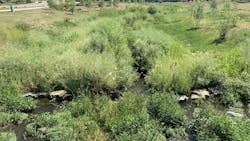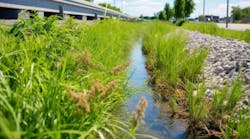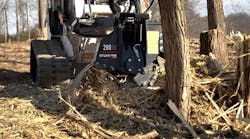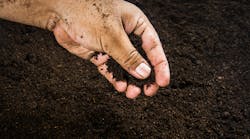Vegetated urban drainageways provide significant aesthetic, environmental and financial benefits when compared to the concrete and grouted rock design approaches of yesteryear. When drainageway corridors are landscaped with appropriate native plant communities, they offer ribbons of natural open space that benefit the surrounding communities. These planted areas also provide important environmental services, including songbird and raptor habitat; biogeochemical processing of nutrients and other pollutants; sediment sequestration; scour and erosion prevention; shading and associated temperature moderation; and interception and capture of rainfall which moderates peak runoff rates. There is a fiscal argument for using vegetation to achieve desired stabilization — whereas concrete and grouted rock structures have a finite lifespan, planted communities are regenerative and when properly maintained, can persist in perpetuity. When vegetation communities are not maintained, there can be significant consequences. Here are some examples.
- The development of unmanaged weed infestations can require drastic removal and revegetation measures.
- Overgrown plant communities in the floodway slow the movement of flood water downstream, often beyond the roughness coefficients and associated hydraulic modeling used for drainageway design, resulting in unexpected flooding that can cause damages to property and loss of human life.
- Excessive and overgrown plant growth can impede the use of recreational trails, block views, attract encampments, and discourage use of the drainageway by the local community.
- Overgrown plant communities can create significant wildfire hazards due to the accumulation of combustible fuels that can allow fires to rapidly spread.
- Unmaintained plant communities along drainageways can shed branches and other debris that can block drainageway facility features such as culverts and bridge openings, resulting in unexpected flooding during normal storm events.
Although vegetation management can be more nuanced and complex when compared to management approaches for traditional engineered drainageways, the process can be demystified with some thoughtful planning that addresses project design, project construction, and long-term maintenance.
Vegetation Maintenance Considerations During Project Design
Many vegetation maintenance needs can be avoided and minimized with proper consideration of site conditions during the project design phase. First, start with the expected hydrology of the site, including any planned irrigation (either temporary or permanent), precipitation (normal and drought years), and the range of future impacts from upstream land use (e.g., flow diversions, landscape irrigation return flows). Plant stress and mortality due to insufficient water can create opportunities for weed infestations and require plant material replacement. Conversely, installing plants that are adapted for the range of hydrologic conditions at a site can result in a thriving plant community that out-competes weeds and regenerates naturally, with minimal intervention.
One strategy for managing the longterm range of climatic conditions is introducing seeds from a broad spectrum of plants, including some that are adapted to warmer and drier conditions than expected initially. This approach can help a site maintain desired vegetative coverage, even if climate changes result in warmer and drier conditions than present during drainageway design and construction. Given the relatively low cost of seeds and their ability to remain viable within the soil profile for many years, this is a low-cost way to promote long-term drainageway vegetation success. Consider also the floodplain design’s assumed drainageway roughness. Urban drainageway projects are often confined to a narrow corridor due to land use demands and existing structures.
To accommodate design flow events (e.g., the 1% annual exceedance probability flood) within the designed corridor, it is often necessary to plan and design for vegetation communities that create minimal impediments to flows moving downstream. Developing a plan that includes species with natural growth habits compatible with these designed conditions reduces the need for continuous clearing and thinning. For these projects, maintenance needs can be minimized by planting low-grow grasses, shrubs that do not form dense thickets, and trees that are less likely to shed large branches, as a few examples. Incorporating an understanding for local wildfire risks and community wildfire management strategies can help guide selection of plants that are less likely to create thick stands of combustible fuels.
In high risk areas, it may be more appropriate to select plants that produce minimal combustible fuels and/or those resistant to wildfire. Finally, evaluate how managing traffic and uses will or will not be compatible with native vegetation. Unlike non-native turf grasses, many native vegetation communities will not tolerate highuse activities like regular foot traffic or off-leash dog play. Working with project architects to manage traffic and drainageway uses can help avoid the need to replace planted areas. Frequent usemanagement design features include split rail fencing, carefully placed boulders and defined access paths.
Vegetation maintenance considerations during and immediately following project construction
Following the completion of construction, including seed and plant installation, there is a critical maintenance period that persists until plants are successfully established. During this time, vegetation should be regularly inspected for necessary maintenance including:
- Eliminating weed infestations early and before seeds are produced. Nonnative weeds thrive in the disturbed areas of recently completed projects. In most cases, the disturbed soil has a bank of non-native seeds that are ready to germinate. Some sites may require weed elimination programs prior to installing desired seeds and plants. Regular weed management is important until native plants are established and exposed soil is minimized. Eliminating these weeds soon after germination, either mechanically or with selective herbicides, can avoid their establishment and proliferation that could require more costly management measures.
- Identifying stressed or dying plants. Although some plant stress and mortality are expected, regular inspections can help identify problems that can be addressed before they result in widespread plant loss. For example, herbivory of young saplings by deer can be managed inexpensively with temporary wire fencing but if left unaddressed, can result in the total loss of the stand. Another benefit of having a regular inspection program is the ability to distinguish between minor site issues that can be fixed with focused small changes versus identifying larger, persistent issues that may require site modifications.
Long-term vegetation maintenance considerations
As planted areas become successfully established, often six months to one year following planting, it may be appropriate to gradually reduce inspection frequency and transition the site into a long-term maintenance program that may consist of annual selective clearing and inspections. Experience has taught us that it is not advisable to simply walk away at this point and “let nature run its course.” Urban drainageway corridors need to be considered managed landscape features that are subjected to new and different human and natural stressors; including increased use for recreation, wildlife behavior, fluctuating climate conditions, introduced weed infestations, and upstream hydrology manipulations, as a few representative examples. A few best practices for longterm management of urban drainageway vegetation communities include:
- Developing an adaptive management document that specifies the frequency and methodology for inspections, a decision tree for how to address emerging issues, and resources that can be used to inform vegetation management in the future.
- Educating landscape and drainageway maintenance crews on how to avoid inadvertently damaging native vegetation areas during regular thinning and clearing as needed to maintain flood flow conveyance.
Concluding remarks
Established, healthy, native vegetation communities enhance our urban drainageways, benefiting human and environmental values. While a goal for these areas is to appear natural, we must recognize that these areas are subjected to stressors and constraints not found in nature and these plant communities are part of the managed urban landscape. Engaging vegetation specialists during the project design and construction phases can help establish plant communities that require less longterm maintenance. Developing a long-term maintenance plan that incorporates adaptive management approaches and provides a toolkit of appropriate corrective measures can help ensure that the vegetation community is well cared for, long after the original project team members have gone off to other pastures.







